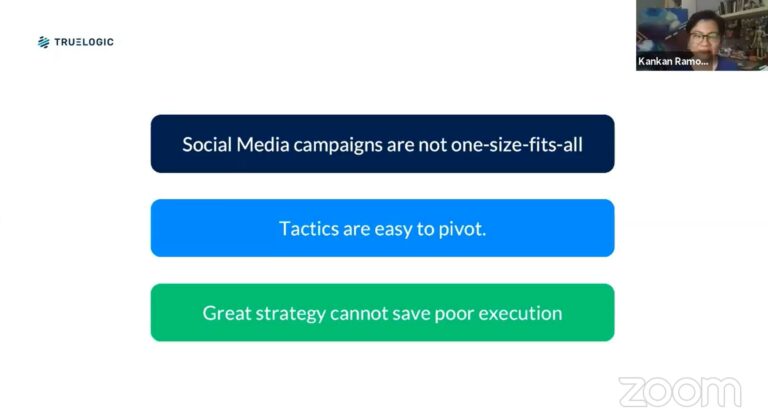Truelogic Episode 43 Recap: You Don’t Need An Iron Man Suit

The web offers a wide array of technologies and it’s easy to get lost in all the choices. Some are straightforward and they tend to be open-sourced. Some are sophisticated and can do anything from simple scheduling to training natural language AI. But with all the technology available to us today, how do you know which technology is for you?
Podcast Transcription
Berns San Juan: In my years of working on the web, and that’s over two decades now, I’ve encountered a lot of web technologies and the wonderful things they can do. My favorite thing about technology is that they solve problems. And you know, if a technology does not solve a specific problem, it isn’t really much of a solution.
Some technologies are pretty straightforward. A lot of the straightforward ones tend to be open source and some are sophisticated. And they can do anything from, let’s say, something as simple as scheduling to something as complicated as training natural language AI. So it can get very complex very quickly. But with all of the technology available to us today, how do you figure out which technology is right for you, your brand, your team, and your business?
Welcome to another episode of the Truelogic DX Podcast. And today, we’re going to talk about web technology. It’s the new year and this is our first podcast for the year. And for some brands, a new year means one thing, a new website, a new app. But I’ve always been puzzled by how brands and businesses make their technology selections when building a platform and then an app, a website. These are just platforms. They’re just channels by which you communicate with your customers.
I think people fall into what I call the car versus designer baby conundrum, right? Why don’t we make our technology selections the way we make our selections for cars? When we buy cars, we try to think about the functionality, how many people we need to fit in, and how much storage space we need. Do we really need four-wheel drive? Do we usually go or do we usually go off-road? How much fuel economy are you going to need? Most of the time, that’s the decision-making criteria that we make whenever we’re picking out a vehicle.
But it seems like when picking out a website, the decision-making is a bit weird like, “Oh, I want a baby with dark curly hair and blue eyes, but Moreno skin, but not too Moreno, ideally, without freckles.” And that’s some magical genetic engineering going on when it comes to site builds. So I think the way people make decisions when it comes to picking technology is a little skewed. The web offers a wide array of technologies and it’s easy to get lost in all of the choices, right?
So take for example, something as simple as open source versus proprietary technologies like Microsoft or Oracle, or IBM which all have their own solutions. How do you know which one is right for you? Most of the time, for most brands, for most businesses, the selection is usually made because of security or because of an existing relationship with one of these providers. Even under open source alone, you’ve got a lot of coding languages to choose from. You’ve got Laravel, Ruby on Rails, Python, Java, and Code Igniter. The list goes on and on and on and on.
But just to be clear, I’m not going to give you a crash course on what these technologies are and what these coding languages are. Instead, I’m going to try to help you figure out which technology you’re ready for, whether you’re ready for something more sophisticated, or whether you need something a bit more simple. And I’m going to give you a few basic decision-making criteria for making your technology selections. So let’s go through that.
How to Choose the Right Web Technology for your Business
Identify your goals
Decision-making criteria number one is goals. Always goals. I think everything starts with goals. When you’re picking out what technology you want to use. Are you going to use IBM’s proprietary technology? Are you going to use an Oracle-based system? Are you going to use something open-source? What are you trying to do? And by the way, please take note, I will always default from simple is better. So I’ll always default to open source. And if the answer is not open source, I think that’s when you begin considering more sophisticated technology.
-
What are you trying to do?
And for 90% of websites out there, you’re trying to get a customer to buy. So WordPress has solutions for that. Shopify has solutions for that. Magenta has solutions for that. So there are open-source solutions to that goal, but what are you specifically trying to do?
-
Determine your audience or your customers
The other is, what is your audience or your customers? If you’re a publisher, you have no customers, you have audiences. What are your audiences or your customers trying to do? Or what do you want your customers and your audiences to be able to do? So goals.
-
Establish your business goal
The last one is what is the business goal? Are you trying to drive more readership? Are you trying to drive more subscribers? Are you trying to drive more paying subscribers? Are you trying to build out a fan base? Are you trying to get people to be aware of a new product? Are you trying to sell something online? Are you trying to get people to buy a subscription to a SaaS? But what is the goal of the business? So this is the first decision-making criteria. And if an open source platform, if an open source technology has the ability to execute the goal, then you ought to be leaning more to open source. So decision-making criteria number one is goals.
Identify the requirements
-
What do you want to be able to do?
Decision-making criteria number two, requirements. If goals are about what is the business trying to accomplish, what are you enabling your customers and your audiences to do on your site? Requirements mean what does your team need? What does your team need? What does your team need to be able to do? And this can be a lot. It can comprise tracking, what data you collect, how you segregate audiences, what marketing automation you implement, any other form of automation that isn’t marketing, any form of task sequencing that you’re creating, or any custom logic that you might want to be implemented into your platform.
-
Tracking
Now, most of the time, in my experience, when we address what a team needs to be able to do, we don’t normally build it on the website. We build a partner website for it, or we build a partner platform for it, or a dashboard if you will. But an online dashboard is really just a website. It’s just a bit more secure. It’s not available for Google to crawl and index and whatnot. But what do I mean when I say requirements? Does your team need to be able to track, like meaning, do they need to be able to see what the customer does at every stage of the customer’s journey or of the buyer’s journey?
-
Data Collection
Do you collect their email addresses and their names, their phone numbers? Do their locations matter? Do their preferences for products matter? What kind of personally identifiable information are you going to collect?
Now, it’s a great thing that in the Philippines, our data is not highly monetized. There are not a lot of websites that share third-party tracking with other providers. There are some, but there is not a lot. But what kind of data are you collecting? And of course, data privacy, being transparent with your users and whatnot, but what kind of data do you collect? Because the data you collect also determines what kind of next how you segment your audiences.
Take for example, I’ve always told people at Truelogic, the people that inquire about SEO, or the people that visit our SEO solutions pages are our SEO audiences. The people that visit our galleries, our web design portfolio, or our web design service page, are our web design audiences. And so we build out audiences by service, right?
-
Marketing Automation
I have encountered situations where I talk to brands or businesses, and I ask them, “Why are you on that technology?” And they’ll say, “Oh because it’s already got a built-in CRM.” A CRM is a Customer Relationship Management tool. It helps you keep track of who your customers are. And to automate some of that care simulation, it’s about simulating the care, simulating the love. And then I’ll usually ask, “Okay, but why did you need it to be built in?” And in most cases, there’s no logical answer. So what kind of marketing automation do you employ? What kind of automation do you employ just by itself?
Take for example for us, we do a lot of automation. A lot of this stuff like the way we manage projects in sequences. There are algorithms that work in the background for us that determine whether campaigns are healthy or not. It knows when to alert a project manager or not. So there are tasks, sequences, and some custom logic that makes us better than the average player in the market. And so the question there is, do you need that? Does that help impact the business in any tangible way?
I remember telling people a while back, we run about 800 campaigns or 800 projects with less than 100 people. And that’s amazing. But part of what enables that is the task sequencing in our proprietary software and in and inside our project management tool. So these are examples of what you want to be able to do.
-
What are the weights of these specific items versus the goals?
So take note, the goal and the requirement are not the same sometimes and they’re not really opposed, but sometimes, you have to weigh whether the requirement is more important than the goal. Remember, the goal is audience and customer-centric. The requirement is team-centric. So, what are the weights of these specific items that you want to implement versus the goals you stated earlier?
-
How many customers will be affected by the requirements?
The next one is if you implement any of these requirements, how many customers are affected, how many customers are affected by this automation, by this relationship management automation, by this marketing automation, by this algorithm?
-
Is there a person that can own this maximum customization?
Is there somebody like you might choose a platform because you got allowed by the salesman telling you, “Oh, take a look at our data analytics and our custom dashboards. Have a look.” And then after you buy it, you realize no one in your team is qualified to look at the data science to break down, to storify the data that you’re collecting, in which case it was a waste of effort.
So nail down your requirements and try to figure out what is it you really need, which ones are essential, and which ones are optional. And don’t be afraid to list optional tasks. It’s just that if you deploy everything to be perfect, you’ll deploy nothing at all. In product development, there is something that we call the minimum viable product. It’s the product that you need to deploy out there that you need to send out there into the world where it will survive and thrive by itself. And I mean, everything else is just the cherry on top. So two decision making-criteria: the goals, what are the needs of your audiences and your customers? And what are the needs of the business requirements? What are the needs of your team?
Ownership and Accountability
-
Who owns the management of the platform?
Whether that’s a website or an app. Is it going to be your marketing team or do you have a dedicated technical team? Is it going to be your editing team, your content team, or is it your IT team? Are you comfortable with the idea that your platform is constantly going to be managed by a third-party vendor? Or are you going to have to build out a captive team just to manage that technology?
-
Speed of change
The other one is what is your need for the speed of change? When you see something is not working, or when you see something can be worked better, do you have the option of issuing a PO to a provider, waiting several weeks to several months, negotiating rates, and then getting it into their sprints, getting it into their queue? Or do you need something implemented fast?
-
Cost Sensitivity
And then the last one is cost sensitivity. It might be easy to assume that creating a captive team is expensive because we know what the cost of manpower is. But I think what most people don’t realize is highly technical work is not cheap. It was pretty expensive. It can go all the way from like 5000 pesos an hour. It can go from 5000 pesos an hour to over 10,000 pesos per hour. So what is your cost sensitivity?
There have been instances where I got hired to do SEO on a brand and nobody in the brand knew who administered the website. That’s crazy. So the question of ownership needs to be part of the equation when it comes to decision-making criteria. You want to use a technology that’s friendly to the people that will own it in the business, not friendly to the provider, but friendly to the team that will own it in the business. So consider ownership as a criterion.
Dependence or Independence
What I mean by dependence or independence is similar to ownership and accountability, you have to understand how comfortable you are with always having to rely on a third-party vendor versus your own captive team.
Sometimes you have custom old, not really obsolete, but really custom, really old databases that you still need to integrate into your new website. Sometimes you might be in a highly regulated environment, and so the requirements for you are more stringent than everybody else, which requires more customized solutions for you. But do you want to be able to manage this in-house? Or are you comfortable with being dependent on another provider, on another team, or on a third-party team? And that needs to be part of the decision-making criteria.
Diminishing Returns
Another thing that you need to take into consideration is the first few features you bring to your website. Remember, we’ve got goals and then we’ve got asks, the requirements. The first few things you set up will represent 80% of the benefit to your customers and 80% of the benefit to your team. Every additional customized code and every additional customized feature you add on after that will have diminishing returns. Because not all features are created equal. Some have a greater impact than others. Some will save you 160 man-hours. Some will save you five minutes. So not all of them are created equal.
So just know that every hour’s worth of work, let’s say, might cost you… let’s play it safe and say 10,000 pesos worth of work for every high-end technical development that you do is about 10,000 pesos. Let’s say your 1st 100,000 is going to affect 80% of your users. But 100 hours in and the next few 10,000 pesos that you invest the next few technical hours you invest are not going to have as much impact as the first few hours you’d put in. So technology has diminishing returns. Try to not get overly crazy with the customizations that you need on your site, especially not to the detriment of your goal and your requirement.
Open Source vs. Captive Technology
Should you go to custom programming languages or open-source CMS-powered websites? When I say open source CMS, I mean WordPress, Shopify, Magenta for those of you guys that still use it, like Drupal, and for those of you guys that still use it, these are CMS-powered websites.
Custom Programming Languages vs. CMS-powered sites
When do you go for custom programming languages versus CMS? And the answers are those things that I mentioned above. Whether to go open source or whether to go open source CMS powered or whether to go custom technology needs to be determined by what are the goals of the business and what are you trying to get your audience and your customers to do. What are the requirements of the team that will manage it? Who will own the management of the platform, your comfort for dependence or need for independence, and understanding that technology will drive diminishing returns as the project moves forward?
Key Takeaway: Car Analogy
I think the best way to determine this, and I’ll go back to the car analogy. Earlier, I said this decision-making is one of the crazy things because I call it the car versus designer baby conundrum. Because when it comes to picking up technology, I like to use the car analogy. Too many brands and too many businesses don’t like buying cars from the Casa. Let’s treat your website as a car. If the car were an analogy for a website, there are too many brands and too many businesses that are not comfortable buying a car from the showroom.
It seems like everybody is hell-bent on, “Oh, you know what? I need to get from point A to point B alive.” And so the first solution that comes to mind is, “You know what? I’ll build a car from the ground up.” That doesn’t make sense. Not when you could get a City, a Civic, customize the mags, customize the wheels, put in leather seating, put in a ducted tail, put in a spoiler, put in a sunroof. All of these can be customized to your car.
The same is true for your website. When you build something on a CMS, on open source, it’s exactly the same thing as getting a van, a pickup coming from the Casa, coming from the showroom. It’s not just because it’s pre-built does not necessarily mean that it’s not unique. It can be made unique, and it can be customized in a lot of ways.
So the next time, if this is the year you guys are considering rebuilding your website, I hope you have an opportunity to listen to this podcast before you make your technology selections.
Thank you for joining us and for continuing to join us for the Truelogic DX podcast. Please give us a shout-out if there are topics, guests that you’d like us to the field or anything you want to talk about, let us know. You can drop us comments on YouTube and on Facebook. If you aren’t following us, follow us. And I also want to say thank you to our friends at Pod Machine for continuing to power this podcast. Subscribe to our Spotify, Google, and Apple accounts so that you can get alerts whenever we publish a new one. See you in the next episode. Cheers.










